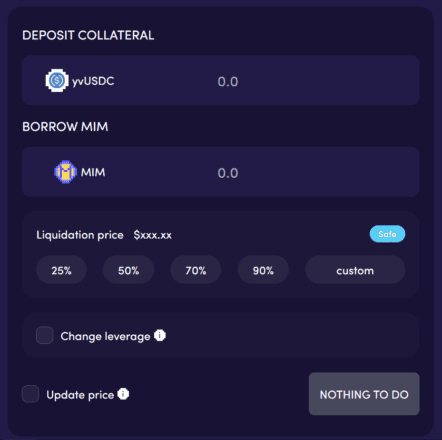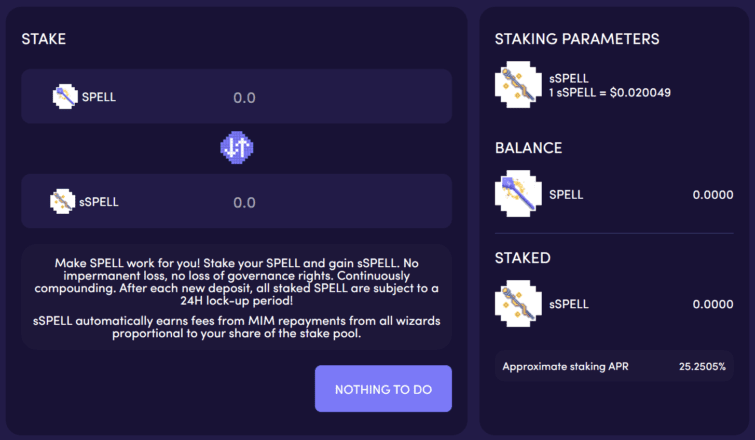DeFi Project Spotlight: Abracadabra.Money, DeFi's Magic Money Spell Book
Abracadabra.Money is a multi-chain lending platform that uses interest-bearing assets as collateral to mint a USD-pegged stablecoin.

Key Takeaways
- Abracadabra.Money is a lending protocol that lets users deposit interest-bearing assets to mint a multi-chain stablecoin called Magic Internet Money.
- Its lending engine allows for leveraged yield farming by unlocking stranded capital to turn what would've otherwise been illiquid assets liquid.
- The fully-collateralized and decentralized stablecoin MIM can be found on all decentralized exchanges across all blockchains.
Share this article
Abracadabra.Money is a lending protocol that allows users to deposit interest-bearing assets as collateral to borrow a stablecoin called Magic Internet Money that can be used across multiple blockchains.
Abracadabra.Money Explained
Abracadabra.Money is a multi-chain lending protocol utilizing interest-bearing assets to mint Magic Internet Money.
It sounds esoteric, but in reality, the idea is quite simple. Abracadabra’s main goal is to unlock what would have otherwise been stranded capital in DeFi to empower users to yield farm with leverage. The protocol achieves this by allowing users to deposit interest-bearing assets such as Ethereum, USDT, or USDC deposited in Yearn.Finance’s pools as collateral to borrow or mint a U.S. dollar-pegged stablecoin called MIM.
Abracadabra’s co-founder, who goes by the alias Squirrel, says the idea for the project was born out of the dire need for a decentralized stablecoin that is better than the current alternatives—one that is truly decentralized, provides utility, and is primed for the multi-chain world. “We saw an opportunity to create a stablecoin that is solely backed by interest-bearing assets,” he says. Squirrel believes that Abracadabra’s direct competitor, MakerDAO, has strayed too far away from DeFi’s core values. He explains:
“DAI has become a very unattractive stablecoin. We were fans when it was Ethereum-collateralized, but at this stage, DAI is 60% collateralized by USDC. A supposedly decentralized stablecoin that is primarily collateralized by a centralized stablecoin—it’s ridiculous.”
To understand Abracadabra’s economic moat, it’s worth looking at how regular yield farming and conventional decentralized stablecoins function today. With standard yield farming, users typically deposit or stake liquid assets like USDT or SUSHI into yield farms like Yearn or Sushi. In exchange, users receive illiquid interest-bearing tokens such as yUSDT and xSUSHI that essentially represent “receipts” to retrieve the original deposits along with any accrued yield. In other words, liquid tokens go in, and illiquid interest-bearing tokens come out.
Conversely, minting a conventional decentralized stablecoin like DAI requires depositing liquid assets like Ethereum or USDC as collateral to get liquid stablecoin tokens like DAI out. That means liquid tokens go in, and liquid tokens come out.
Abracadabra, on the other hand, combines the two approaches. It lets users deposit illiquid interest-bearing tokens like yUSDT and xSUSHI as collateral to mint a liquid asset: MIM. This opens up leveraged yield farming opportunities by unlocking stranded capital or making what would’ve otherwise been illiquid assets liquid. Explaining the possibilities Abracadabra unfolds, Squirrel says:
“With Abracadabra, users can leverage up their yiled farming positions to earn more fees. Of course, there’s a risk that comes with that, namely the risk of liquidation, but it’s still a completely new way of market-making in the decentralized world.”
To better understand Squirrel’s point, consider the following yield farming strategy. Suppose a user wants to earn interest on $10,000 in stablecoins. One thing they could do is deposit 10,000 USDT into the Yearn USDT Vault, currently yielding around 2.1% net APY. The depositor will receive yvUSDT tokens, which are effectively “receipts” for staking or interest-bearing tokens representing the staked deposit.
The user can now take these interest-bearing yvUSDT tokens and use them as collateral to take out a loan on Abracadabra. Since these tokens effectively represent $10,000 worth of staked stablecoins, the interest or the cost for taking out this loan is roughly 0.8% a year and the user can borrow up to 90% of their value.

This means the user earns 2.1% APY on their deposit, takes out a loan costing 0.8% of the year, and receives 90% of his original value in MIM. This means he has $9,000 worth of liquid capital in MIM and still makes 1.3% APY on his original deposit.
The user could even continue leveraging his position up to 10 times with Abracadabra’s lending engine. In the background, the protocol will exchange the MIM tokens back to USDT, deposit them into Yearn for the 2.1% APY, use the yvUSDT LP tokens to borrow more MIM, and repeat the process until the desired leverage is achieved. This is done automatically and allows for a $10,000 deposit to earn yield on the equivalent of $100,000 minus loan interest fees.
Synergy with Popsicle Finance
In the background, Abracadabra uses Sushi’s Kashi Lending Technology to provide isolated lending markets that enable users to adjust their risk tolerance according to the collateral they decide to use. The lending engine plays off synergies with other DeFi protocols to allow for some powerful yield farming strategies. Squirrel explains:
“In the near future, we will be able to leverage liquidity providing on Popsicle Finance using Abracadabra. For example, a user picks a trading pair on the Popsicle automated market maker, say ETH/USDT, deposits the funds into the pool, and picks a leverage level. Then we use the Abracadabra Degen Box engine where the initial ETH/USDT LP tokens get deposited, automatically borrow MIM against the LP tokens as collateral, and then use the borrowed MIM to purchase and deposit more ETH/USDT back into the said pool based on the desired leverage.”
Popsicle Finance is a multi-chain yield optimization platform for liquidity providers built by the same experienced team behind Abracadabra. Its vision is to be the market maker of DeFi—a protocol that optimizes liquidity providing across all chains and decentralized exchanges. To do that, Squirrel says, Popsicle needed a separate but synergistic protocol like Abracadabra. He explains:
“If you think about it, to be a proper market maker, you need a reliable place where you can borrow, and a stablecoin that’s available everywhere. Abracadabra provides both. The lending platform allows users to create any isolated risk lending market they want, and with MIM being that multi-chain stablecoin, we can easily shift liquidity across ecosystems.”
MIM aims to be the decentralized stablecoin for the multi-chain world. By leveraging the AnySwap cross-chain protocol, users can currently transfer MIM from Arbitrum to Fantom within 10 minutes. The stablecoin already runs on all decentralized exchanges across all blockchains, sidechains, and Layer 2 protocols. “MIM is the only stablecoin that currently does that,” says Squirrel.
Tokenomics and Governance
Abracadabra has two tokens: MIM, the USD-pegged multichain stablecoin, and SPELL, the protocol’s utility and governance token used for fee-sharing and incentivization.
The SPELL token has a total supply of 210 billion coins, 63% of which are used to incentivize particular liquidity provider pairs or other liquidity mining programs to ensure deep liquidity for the project’s markets. The token emissions follow a ten-year halving model where SPELL rewards are cut in half every year. Most recently, the team made a proposal to reduce the farming incentives by 20% and instead burn those SPELL tokens.

Furthermore, SPELL can be staked in the Wizard Dashboard to obtain sSPELL tokens, used for fee-sharing in the SPELL staking pool and governance of the Abracadabra DAO. All of the fees the protocol makes from interest, borrow, and liquidation fees are distributed in the SPELL single-sided staking pool in the form of SPELL tokens, currently yielding around 25% APR.
Abracadabra’s governance happens through a snapshot page where sSPELL and SPELL/ETH Sushiswap liquidity provider token holders can make or vote on protocol improvement proposals. To that end, building a community-driven project through decentralized governance is paramount for Abracadabra.
Abracadabra and its affiliated projects Popsicle Finance and Wonderland Money form part of a group of fast-growing DeFi projects called Frog Nation. Supporters of the projects, including Squirrel and Daniele Sestagalli, another of Abracadabra’s co-founders, recently launched a social media campaign under the hashtag #OccupyDeFi to spread the word about its mission.
“For us, #OccupyDeFi is all about focusing on actually creating decentralized finance, and not this semi or quasi-decentralized finance,” says Squirrel, arguing that other DeFi protocols have succumbed to VCs and institutions at the cost of decentralization and the broader community.
The Future for Abracadabra
Abracadabra’s roadmap plans include automating liquidations, creating more utility for MIM, and expanding across the entire DeFi universe.
Liquidations on Abracadabra currently aren’t automatic, and users can’t bid or compete to liquidate other borrowers’ collateral. Instead, liquidations are currently handled manually by the team, which is far from being the most optimal or equitable process. However, Squirrel says that Abracadabra is currently working with another project on a solution to automate liquidations. He explains:
“We want to introduce a pool where users can deposit funds, have that pool automatically liquidate certain positions based on signals, and then share the profits from the liquidation fees with the depositors.”
Besides that, Abracadabra wants to give MIM more utility and make it the biggest decentralized stablecoin in the space. This means integrating more collateral assets, expanding to more chains, and building a strong and loyal community. “We’re never going to stop. If there are users on a different chain or a decentralized exchange, there’s no reason for us not to be there,” explains Squirrel.
In conclusion, Abracadabra is an ambitious project building a superior product that is trying to fill what seems to be a real gap in the market-making and stablecoin corner of decentralized finance. The incredible pace at which the project is growing indicates that Abracadabra has found the perfect product-market fit. “The frog nation will win,” Squirrel concludes. For him, the fight to keep DeFi, open, decentralized, and censorship-resistant has only just begun.
Disclosure: At the time of writing, the author of this feature held ETH and xSUSHI.
Share this article
